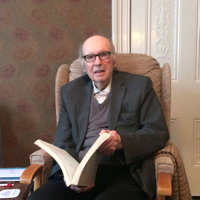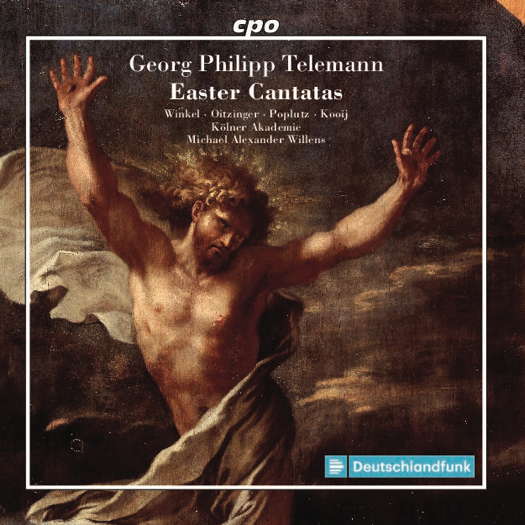 SPONSORED: CD Spotlight. Well Realized - Varda Kotler and Israel Kastoriano - recommended by Geoff Pearce.
SPONSORED: CD Spotlight. Well Realized - Varda Kotler and Israel Kastoriano - recommended by Geoff Pearce.
All sponsored features >>
 SPONSORED: Profile. A Gold Mine - Roderic Dunnett visits Birmingham to talk to John Joubert.
SPONSORED: Profile. A Gold Mine - Roderic Dunnett visits Birmingham to talk to John Joubert.
All sponsored features >>
 DISCUSSION: What is a work? John Dante Prevedini leads a discussion about The performing artist as co-creator, including contributions from Halida Dinova, Yekaterina Lebedeva, Béla Hartmann, David Arditti and Stephen Francis Vasta.
DISCUSSION: What is a work? John Dante Prevedini leads a discussion about The performing artist as co-creator, including contributions from Halida Dinova, Yekaterina Lebedeva, Béla Hartmann, David Arditti and Stephen Francis Vasta.

The Greatness of Easter
Georg Philipp Telemann's Easter Cantatas, reviewed by GIUSEPPE PENNISI
'... a good complement to the "Markus-Passion" CD ...'
A few months ago - on 30 March 2021 - I reviewed a rare recording of Georg Philipp Telemann's Markus-Passion 1759, produced by the CPO label: then my review underscored the dramatic power of the rendering. With this CD containing a selection of Telemann's Easter Cantatas, CPO continues its exploration of this composer. The main theme is not drama, as fits the Passion, but greatness and joy as appropriate for Easter. The conductor and his team are Michael Alexander Willens, the Kölner Akademie, soprano Johanna Winkel, alto Margot Oitzinger, tenor Goerg Poplutz and bass Peter Kooij. Willens is an American conductor now at the helm of the Kölner Akademie, but who had made a name for himself with his performances of lesser known American composers. To the best of my knowledge, there are only two previous recordings of Telemann's Easter Cantatas: one is dated 1997 and the other 2015. They are both hard to find.
Georg Philipp Telemann was a German Baroque composer and multi-instrumentalist. Almost completely self-taught in music, he became a composer against his family's wishes. After studying in Magdeburg, Zellerfeld, and Hildesheim, Telemann entered the University of Leipzig to study law, but eventually settled on a career in music. He held important positions in Leipzig, Sorau, Eisenach, and Frankfurt before settling in Hamburg in 1721, where he became musical director of that city's five main churches. He is less known than deserved.
The CD presents a selection of five works from the extensive, largely unexplored Easter Cantatas oeuvre created by Telemann during the course of his sixty years in Eisenach (1708-12), in Frankfurt am Main (1712-21) and in Hamburg (1721-67). Four of the works recorded date from the 1720s and take us back to the years in Telemann's creative life as a composer when he was the new music director of Hamburg's churches and was reorganizing the city's church music and modernizing it in musical respects. The two cantatas from the 'Annual Cycle without Recitatives' refrain from use of larger ensembles with brass and woodwind instruments and concertizing instrumental voices; the focus is on the arias and quotations from the Bible, and of these it is above all the opening dictum that is very extensive and often elaborated with rich counterpoint. The annual cycle has an intimate, subdued character. Its music does not score points with tonal effects; instead, it generates appeal with refinements in the musical setting of the texts. The cantatas of the 'Second Lingen Annual Cycle' are characterized by a fixed sequence of movement forms. The initial sinfonia is followed by an accompagnato recitative, and this weighty exordium is succeeded by two duets in alternation with chorale strophes. The duets are da capo arias and designed in such a way that one voice sings the A part, while the other voice sings the B part.
Let us now go to some key points of the cantatas; for readership convenience, the titles are in English translation not in baroque German. The first two cantatas are for Church functions on the first day of Easter. There is an explosion of happiness, underlined especially in the choral parts.
Listen — Telemann: Der Tod ist verschlungen in den Sieg
(Triumph! Ihr Frommen freuet euch)
(track 12, 0:00-0:28) ℗ 2021 Deutschlandradio :
In the second Cantata, the greatness of Easter Day is underscored from the short but very effective symphony.
Listen — Telemann: Sinfonia (Triumph! Ihr Frommen freuet euch)
(track 7, 0:01-0:44) ℗ 2021 Deutschlandradio :
The second Cantata is rightly titled Triumph! You pious one, rejoice. Whilst in the first cantata, there is an aria for each vocalist, in the second there are two duets between bass and soprano and alto and soprano as well as a recitative accompagnato by the tenor dominate the vocal part.
Listen — Telemann: Triumph! Ihr Frommen freuet euch
(Triumph! Ihr Frommen freuet euch)
(track 8, 0:00-0:25) ℗ 2021 Deutschlandradio :
The third Cantata is for the second day of Easter. There is no introduction and only men's voices (tenor and bass) are included with the alto appearing in a duet with the tenor in the seventh and final section.
Listen — Telemann: Triumph, ihr Menschenkinder!
(Er ist auferstanden)
(track 21, 0:00-0:31) ℗ 2021 Deutschlandradio :
It is a concise account of the Resurrection. More elaborate is the fourth Cantata, Did not our hearts burn in us: for the second day of Easter too. Its six pieces include arias, duets and chorale. Especially impressive are the alto aria and the final chorale to Father, Son and Holy Spirit.
Listen — Telemann: Lernt das Eitle doch verachten
(Brannte nicht unser Herz in uns)
(track 25, 0:20-1:00) ℗ 2021 Deutschlandradio :
Finally, the fifth and final cantata on this CD: an invitation to the congregation, on the third day of Easter, 'to awake from your deep sleep' in order to fully grasp the meaning of the Redemption. Duets and chorales are the main elements: the last chorale is fascinating.
Listen — Telemann: Ist meine Bosheit groß, so werd ich ihr doch los
(Verlass doch einst, o Mensch)
(track 33, 0:21-0:37) ℗ 2021 Deutschlandradio :
In short, this is a good complement to the Markus-Passion CD to get familiar with, and understand, an important baroque composer.
Copyright © 7 September 2021
Giuseppe Pennisi,
Rome, Italy

CD INFORMATION - TELEMANN: EASTER CANTATAS


